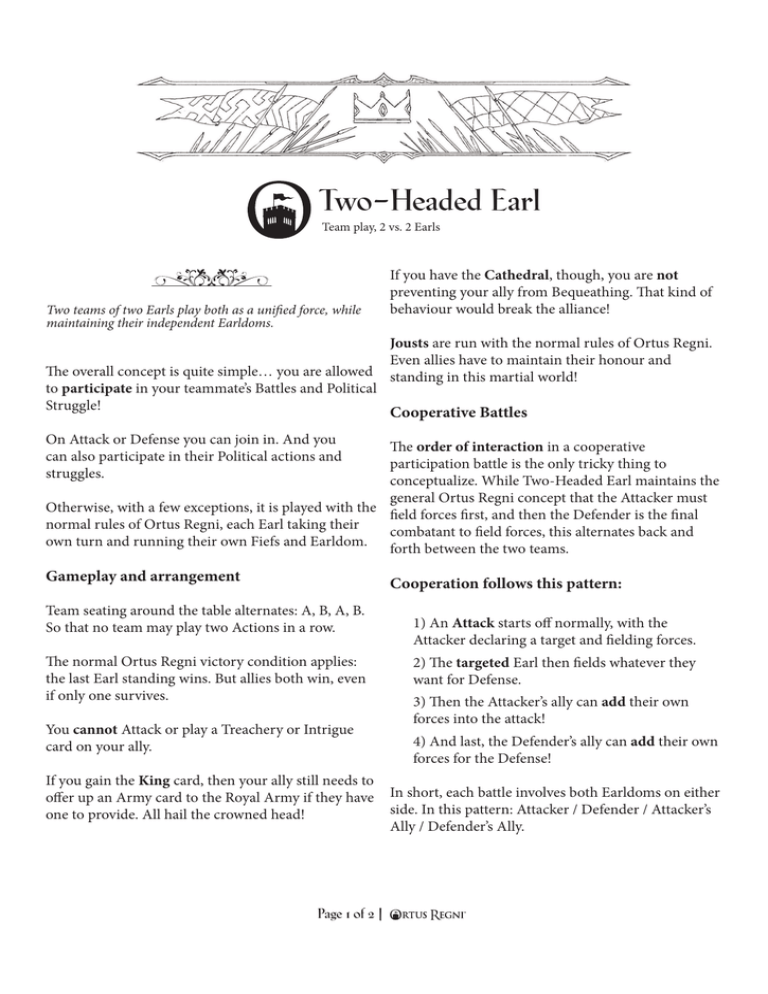A4 - Ortus Regni
advertisement

Two-Headed Earl Team play, 2 vs. 2 Earls Two teams of two Earls play both as a unified force, while maintaining their independent Earldoms. The overall concept is quite simple… you are allowed to participate in your teammate’s Battles and Political Struggle! If you have the Cathedral, though, you are not preventing your ally from Bequeathing. That kind of behaviour would break the alliance! Jousts are run with the normal rules of Ortus Regni. Even allies have to maintain their honour and standing in this martial world! Cooperative Battles On Attack or Defense you can join in. And you can also participate in their Political actions and struggles. The order of interaction in a cooperative participation battle is the only tricky thing to conceptualize. While Two-Headed Earl maintains the general Ortus Regni concept that the Attacker must Otherwise, with a few exceptions, it is played with the field forces first, and then the Defender is the final normal rules of Ortus Regni, each Earl taking their combatant to field forces, this alternates back and own turn and running their own Fiefs and Earldom. forth between the two teams. Gameplay and arrangement Cooperation follows this pattern: Team seating around the table alternates: A, B, A, B. So that no team may play two Actions in a row. The normal Ortus Regni victory condition applies: the last Earl standing wins. But allies both win, even if only one survives. You cannot Attack or play a Treachery or Intrigue card on your ally. If you gain the King card, then your ally still needs to offer up an Army card to the Royal Army if they have one to provide. All hail the crowned head! Page 1 of 2 | 1) An Attack starts off normally, with the Attacker declaring a target and fielding forces. 2) The targeted Earl then fields whatever they want for Defense. 3) Then the Attacker’s ally can add their own forces into the attack! 4) And last, the Defender’s ally can add their own forces for the Defense! In short, each battle involves both Earldoms on either side. In this pattern: Attacker / Defender / Attacker’s Ally / Defender’s Ally. Damage Assignment Gameplay notes Damage is assigned normally, but it is assigned by the Attack initiator and the defending targeted Earl respectively. They can assign any damage points as they wish to their own fielded forces or their ally’s fielded forces. They are the commanders on the battlefield. This variant actually plays out much like a normal Ortus Regni duel, with the same dramatic pace and sudden twists of fate. Captured spoils go to the Attack initiator. Any Ransoms also only go respectively to the Attack initiator or the targeted Defender. But each Earl on the battlefield can choose whether to Ransom their own Lords as they see fit. Cooperative Politics Political events do not go back and forth in the same way. Politics goes initiator (A) then B, B to A, A to B, B etc. An Earl must initiate a political action alone, as normal, by playing a Treachery or Intrigue on an opposing Earl. One thing you will immediately notice is that battles with numerous Lords fielded - on both sides - are very nerve-wracking as a debacle for one side can occur. Minimizing that danger or controlling the Church Decides Battle result feels that much more important. Or you can try to include more Army cards into your strategy to ameliorate the risk cost of captured Lords. Typically in this and other team play modes focusing your efforts to remove one of the opponent Earls is the key to winning. Yet in this variant you are facing both opposing Earls whenever you “lock horns.” Coordinating a team’s decks to some extent is not a bad idea, but we have found that over specialized and over coordinated decks can be deceptively weak if your team’s strategy fails to perform. It can still be fun to try out extreme strategies, though! Then the targeted Earl can play an Allies card to counter that. If they do not, or cannot, then their Ally As far as in-game communications go, play as you wish. All communications between allies that occurs may step-in and play an Allies card on their behalf. “over the table” is reasonable, since that is shared with A Political Struggle proceeds in this fashion as well. the other team. After your side plays a Treachery card, for example, which is then countered by either of your opponents, Using the Free Mulligan rule also works well in team the Earl who played the Treachery card has a chance play. As does using the Tournament Rules, if you want to minimize the opportunity for early stumbles. to play a Vassal, if they do not then their Ally may play one. Note that in cooperative Political Struggles only 1 Vassal is played out at a time from either side. Otherwise the normal rules for resolving a Political Struggle apply. Page 2 of 2 |



